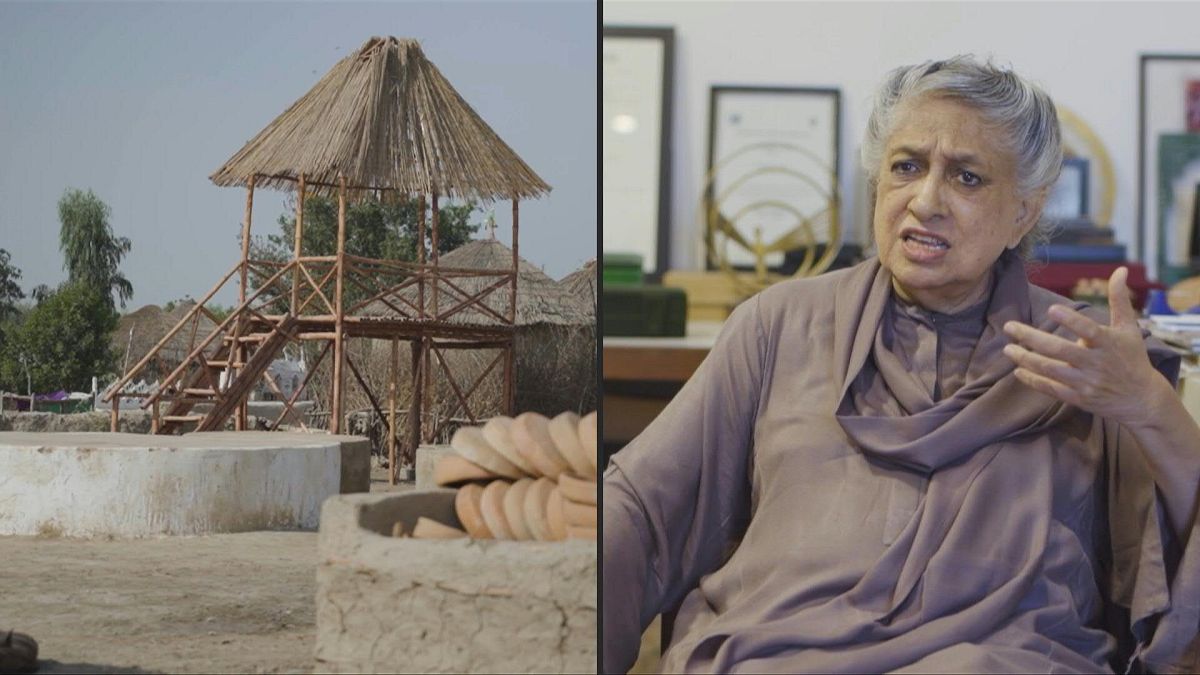Yasmeen Lari was awarded the 2023 Royal Gold Medal by the Royal Institute of British Architects for her dedication to using architecture to change people's lives.
At 82 years old, architect Yasmeen Lari is forging a path to survival for Pakistan's rural communities living on the frontline of climate change.
The esteemed architect swapped designing luxury homes in the capital for developing pioneering flood-proof bamboo houses in vulnerable communities.
The few pilot settlements already constructed are credited with saving families from the worst of the catastrophic monsoon flooding that left a third of the country underwater last year.
Now, Lari is campaigning to scale up the project to one million homes made from affordable local materials, bringing new jobs to the most vulnerable areas.
Who is Yasmeen Lari?
Lari was Pakistan's first female architect. She spent much of her career working on multi-million dollar projects in the megacity of Karachi.
The architect, who trained in the United Kingdom, is behind some of Karachi's most notable buildings. She is known for brutalist constructions such as the Pakistan State Oil headquarters, as well as a string of luxury homes.
As she was considering retirement, a series of natural disasters - including a massive earthquake in 2005 and flooding in 2010 - made her think again.
"I had to find the solution, or find a way by which I could build up the capacities of people so that they could fend for themselves, rather than waiting for outside help," she explains.
"My motto is zero carbon, zero waste, zero donor, which I think leads to zero poverty."
Why do we need to build flood-proof housing?
Climate change is making monsoon rains heavier and more unpredictable, scientists say. The need to flood-proof the country is now more urgent than ever, particularly as the poorest communities live in the most vulnerable areas.
Pakistan has the world's fifth-largest population. It is responsible for less than 1 per cent of global greenhouse gas emissions but is one of the nations most vulnerable to the effects of extreme weather.
Pono Colony, a few hundred kilometres outside Karachi, is made up of around 100 houses. It was developed just months before catastrophic monsoon rains arrived last summer and displaced eight million people.
The village's elevated homes are protected from rushing water, while their bamboo skeletons, which go deep into the ground, can withstand pressure without being uprooted.
"We continued to live in them," says Khomo Kohli, a 45-year-old resident of Pono Colony village.
"The rest of the residents had to move onto the road where they lived for two months until the water receded."
In rural Sindh, tens of thousands of people are still displaced and stagnant water stands in large parts of farmland almost a year after the country's worst-ever floods.
The World Bank and Asian Development Bank in a joint study estimated Pakistan sustained €29.7 billion in damage and economic losses and would require €15 billion for reconstruction and rehabilitation.
What do flood-proof homes look like?
Known locally as "chanwara", the mud huts are an improved take on the traditional single-room houses dotted along the landscape of southern Sindh province and Rajasthan state in India.
They require only locally available materials: lime, clay, bamboo and thatching.
With straightforward training for locals, they can be assembled at a cost of around €157, roughly an eighth of the cost of a cement and brick house.
"I call it a kind of co-building and co-creation, because the people have an equal part in embellishing it and making it comfortable for themselves," says Lari.
She recalls working on social housing in Lahore in the 1970s, when local women pored over her plans and probed her on where their chickens would live.
"Those chickens have really remained with me, the women's needs are really the uppermost when I'm designing," she explains.
This time around, the redesign of traditional stoves has become a significant feature. They are now lifted off the floor.
"Earlier, the stove would have been on the ground level and so it was immensely unhygienic,” says Champa Kanji, who has been trained by Lari's team to build stoves for homes across Sindh.
“Small children would burn themselves on the flames, stray dogs would lick pots and germs would spread."
Lari's work has been recognised by the Royal Institute of British Architects, which awarded her the 2023 Royal Gold Medal for her dedication to using architecture to change people's lives.
Watch the video above to learn more about Yasmeen’s flood-proof housing.



